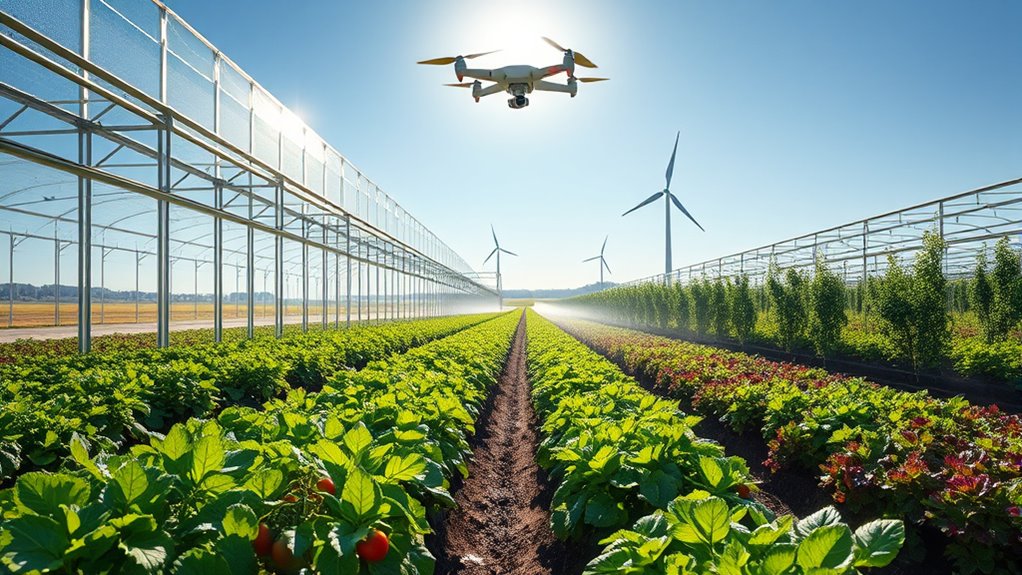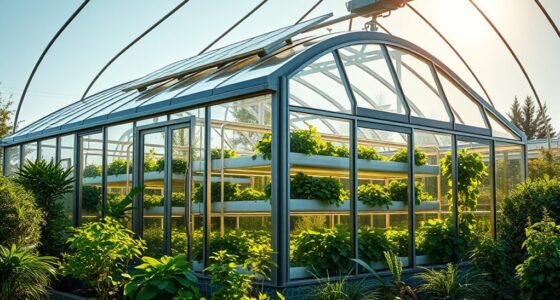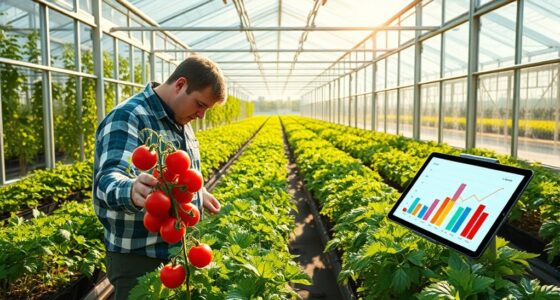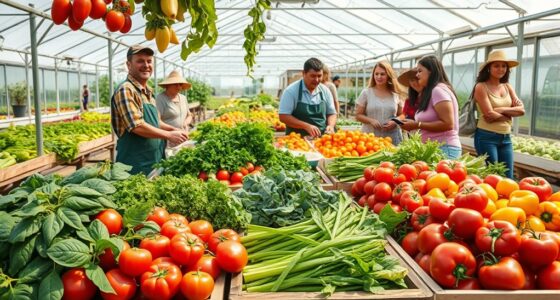The future of greenhouse farming is bright and tech-driven. You’ll see innovations like IoT devices and AI to monitor crops in real time and optimize resources. Sustainable practices, like hydroponics and vertical farming, will dramatically reduce water usage while maximizing yields. As urban areas grow, greenhouses will play an essential role in ensuring fresh produce is accessible year-round. There’s much more to explore about how these developments can shape agriculture’s next chapter.
Key Takeaways
- Technological innovations like IoT, AI, and robotics will streamline greenhouse operations and maximize efficiency in resource usage.
- Vertical farming will expand, optimizing land use and significantly reducing water consumption while ensuring year-round food production.
- Sustainable practices will become integral, prioritizing organic methods and precision farming to enhance soil health and minimize environmental impact.
- The greenhouse market is projected to grow significantly, driven by increasing demand for fresh produce and integration of renewable energy technologies.
- Urban greenhouses will enhance food security, create jobs, and foster community engagement while improving air quality in cities.
Advancements in Greenhouse Technology
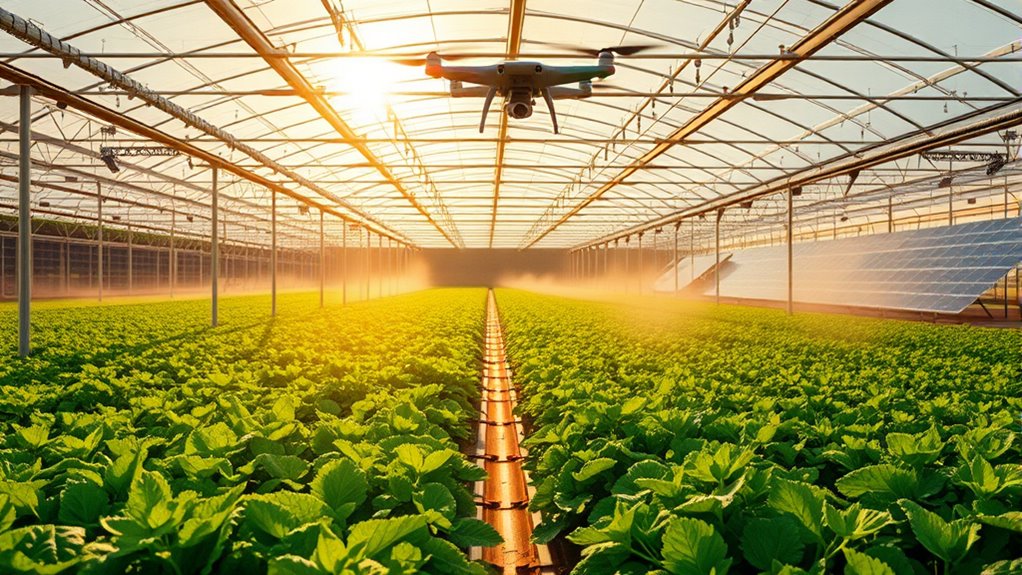
As technology evolves, advancements in greenhouse farming have transformed how crops are cultivated and managed. You can now harness IoT devices to gather real-time data on environmental conditions, allowing for precise control over irrigation and fertilization. With AI algorithms analyzing this data, predicting crop health and automating tasks like ventilation becomes effortless. Automated systems further optimize resource usage, minimizing your hands-on involvement. Additionally, the integration of advanced technologies enhances food production efficiency and sustainability. For instance, using solar-powered solutions such as solar lighting and security systems can help create an energy-efficient greenhouse environment. Incorporating nutrient-rich crops like kale can further improve the health benefits of your greenhouse produce. Robotics play an essential role, handling jobs like harvesting and pest management efficiently, while smart shopping can help you find the best tools and equipment for your greenhouse. Plus, innovative greenhouse designs incorporate effective ventilation and light diffusion techniques to enhance plant growth.
Sustainable Practices for Modern Agriculture
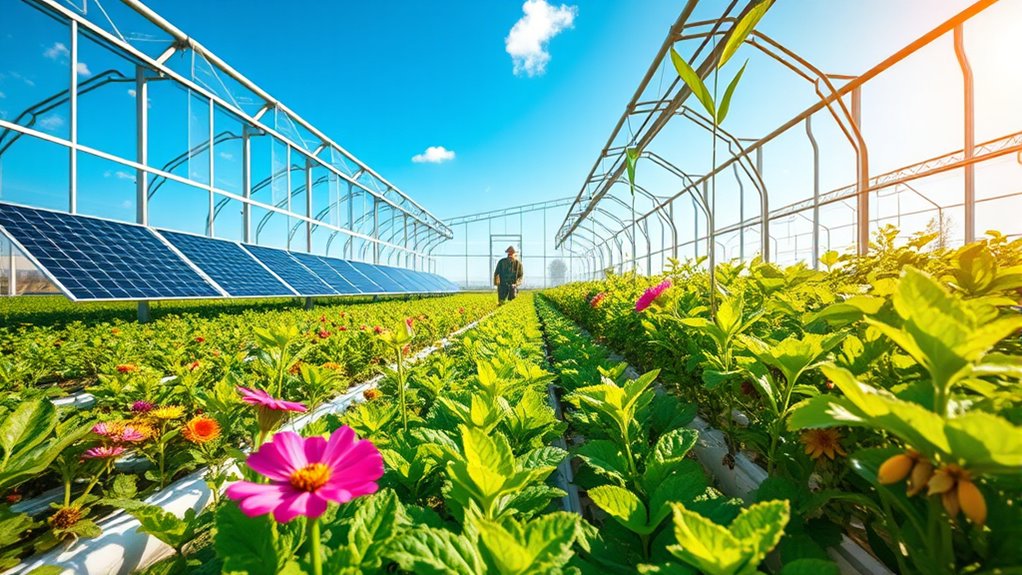
Innovations in greenhouse technology pave the way for sustainable practices in modern agriculture, allowing you to cultivate crops while minimizing environmental impact. You can enhance soil health through crop rotation and diversification, and embrace organic farming to prioritize natural methods over synthetic inputs. Conservation tillage helps retain water and reduce erosion, while agroforestry integrates trees, boosting biodiversity. Additionally, implementing precision farming techniques can optimize resource use, further increasing sustainability in greenhouse operations. A well-designed backyard greenhouse can also help extend your growing season, allowing for year-round cultivation. Heat pumps can be integrated into greenhouse systems to provide efficient temperature control, enhancing the overall growing conditions and energy efficiency.
Incorporating backyard greenhouses allows for greater control over growing conditions and can significantly improve crop yields. For pest control, you can utilize biological methods, cutting down on chemical pesticides. Implementing efficient irrigation systems, like drip irrigation, conserves water, and rainwater collection reduces your dependency on external sources.
The Rise of Vertical Farming
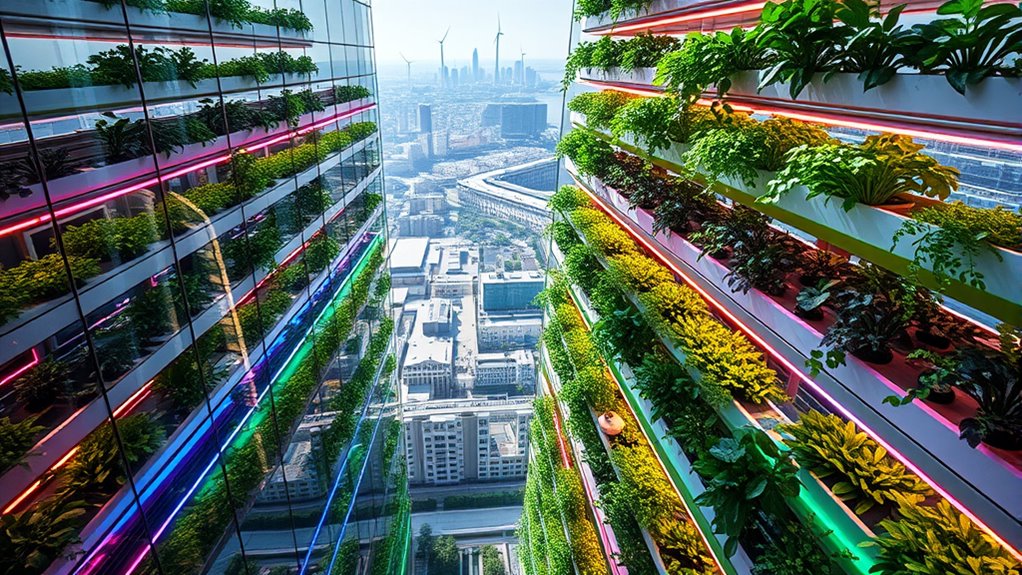
While urban populations continue to grow, the rise of vertical farming offers a promising solution to meet the increasing demand for food in limited spaces. By stacking crops in vertically arranged layers, you can maximize food production without needing vast areas. This method thrives in controlled environments, ensuring ideal conditions for a wide variety of crops, from leafy greens to strawberries. Vertical farming considerably reduces water usage—up to 95% compared to traditional methods—while conserving soil and enhancing climate resilience. Additionally, vertical farming utilizes 98% less water compared to conventional farming, showcasing its efficiency in resource management. Innovations like hydroponics, AI, and automation boost efficiency and lower costs, making it a perfect companion to ground source heat pumps, which can further enhance sustainability in urban agriculture. By bringing farms closer to consumers, you not only cut transportation costs but also contribute to food security, making vertical farming an essential part of sustainable urban agriculture.
Current Market Trends in Greenhouse Farming
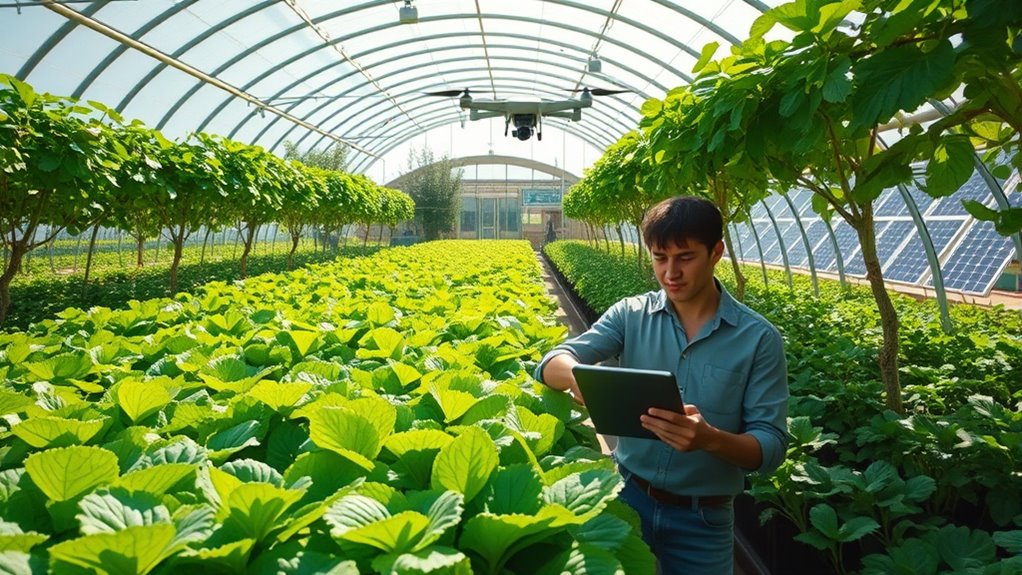
With the global greenhouse market projected to reach USD 59.64 billion by 2031, current trends highlight significant growth opportunities driven by technological advancements and rising food demand.
You’ll notice that the U.S. market alone is set to hit USD 8.5 billion in 2024, showcasing a CAGR of 9.7%.
Europe is expected to capture about 33.5% of global revenue, while the Asia-Pacific region is poised for the fastest growth, emphasizing food security. This growth aligns with the increasing focus on sustainable agriculture practices, which are crucial for meeting future food needs. Additionally, the integration of hydrogen fuel cells in energy systems can further enhance the sustainability of greenhouse operations.
Innovations like IoT devices and AI are enhancing efficiency, optimizing crop yields, and cutting labor costs through automation.
As urbanization continues, the demand for space-efficient food production solutions like greenhouses will only rise, making this sector ripe for investment and expansion. Moreover, the integration of renewable energy technologies is expected to further improve greenhouse sustainability and lower operational costs.
Environmental Impact of Greenhouses
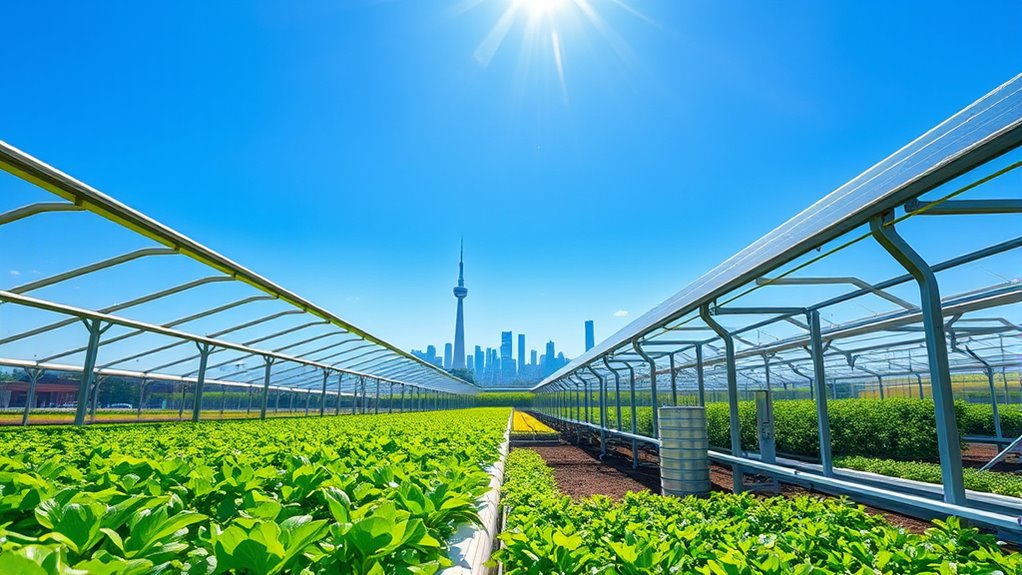
Greenhouses offer a compelling solution to some of the environmental challenges faced by traditional agriculture, particularly regarding resource management and emissions. While constructing greenhouses requires materials like steel and aluminum—each with considerable carbon footprints—their benefits often outweigh these impacts. You can enhance water efficiency through hydroponics and aeroponics, drastically reducing consumption. Furthermore, growing food in greenhouses can shrink carbon footprints by reducing conventional farming impacts. By recapturing fertilizers and employing biological pest control, you limit waste and avoid harmful runoff. Additionally, optimizing energy use with automation and renewable sources like solar panels can greatly cut emissions. Greenhouses also conserve land, allowing for increased crop yields while protecting biodiversity. Overall, with sustainable practices, greenhouses can contribute positively to the environment while meeting food demands. The integration of psychological support for farmers dealing with the stresses of modern agricultural practices can further enhance the sustainability of greenhouse farming. Moreover, adopting mindful decluttering in greenhouse operations can lead to improved organization and efficiency, ultimately benefiting productivity and reducing stress. Understanding the importance of effective communication strategies can also help farmers navigate the emotional challenges associated with modern farming practices.
Future Innovations on the Horizon
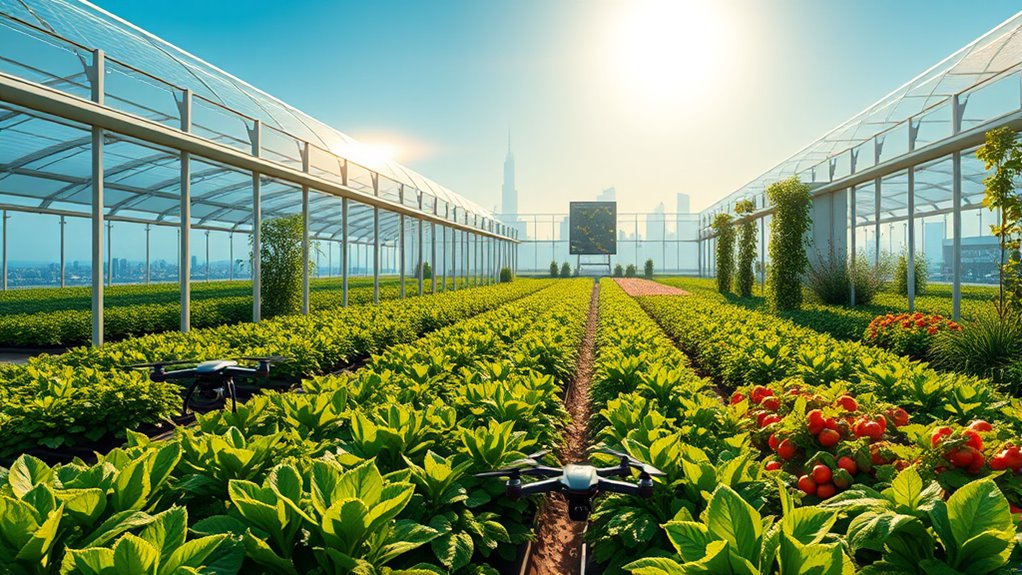
As the demand for sustainable food production grows, future innovations in greenhouse technology promise to revolutionize agriculture. Imagine integrating artificial intelligence to automate climate control and irrigation, enhancing efficiency and crop yields. Spectral-conversion films will filter sunlight, optimizing photosynthesis and boosting production. With vertical farming, you’ll maximize space, achieving higher yields on less land. Hydroponics and aquaponics will further reduce water usage while increasing crop output. Chia seeds could be a valuable addition to greenhouse crops, providing essential nutrients and improving soil health, making them an excellent source of omega-3 fatty acids. Furthermore, implementing geothermal heat pumps can significantly enhance energy efficiency in greenhouse operations by using the Earth’s stable temperature for climate control. Self-sufficient water systems and precision irrigation will minimize waste, ensuring every drop counts. Energy-efficient LEDs tailored for plant growth will cut energy costs and reduce heat output, while the adoption of hydroponics will continue to drive innovation in crop production. Together, these advancements won’t only improve productivity but also create a more sustainable future for greenhouse farming.
Integrating Greenhouses Into Urban Areas
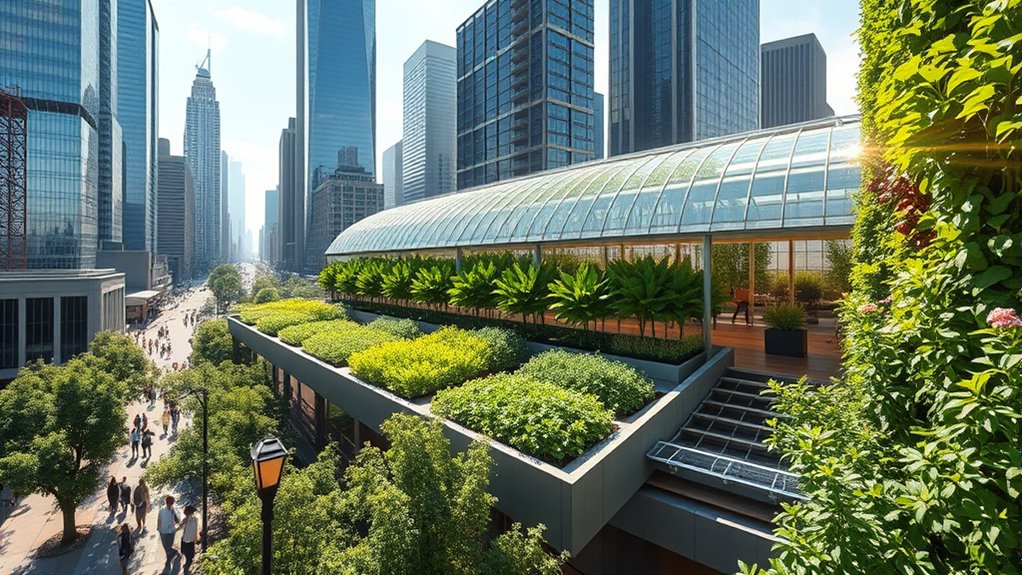
The future of agriculture isn’t just about innovations in technology; it’s also about how we adapt these advancements to urban environments.
Integrating greenhouses into cityscapes offers you year-round access to fresh produce, enhancing food security. These greenhouses can improve air quality by filtering pollutants, while also creating job opportunities that boost local economies. Additionally, urban greenhouses can increase biodiversity by providing habitats for wildlife. Furthermore, they can utilize solar energy to power their systems, reducing operational costs and minimizing their carbon footprint. As these spaces evolve, they can also incorporate senior-friendly design to ensure accessibility for all community members. Moreover, sustainable forestry practices can be encouraged by sourcing materials locally for greenhouse construction, promoting eco-friendly living in urban settings.
By utilizing vertical farming techniques, they maximize space efficiency, making the most out of limited urban areas. You’ll find that sustainable materials and energy-efficient systems minimize environmental impact.
Plus, these spaces foster community engagement, serving as educational hubs that reconnect you with nature. As urban greenhouses flourish, they’ll not only benefit you but also the environment and the entire community.
The Economic Benefits of Greenhouse Farming
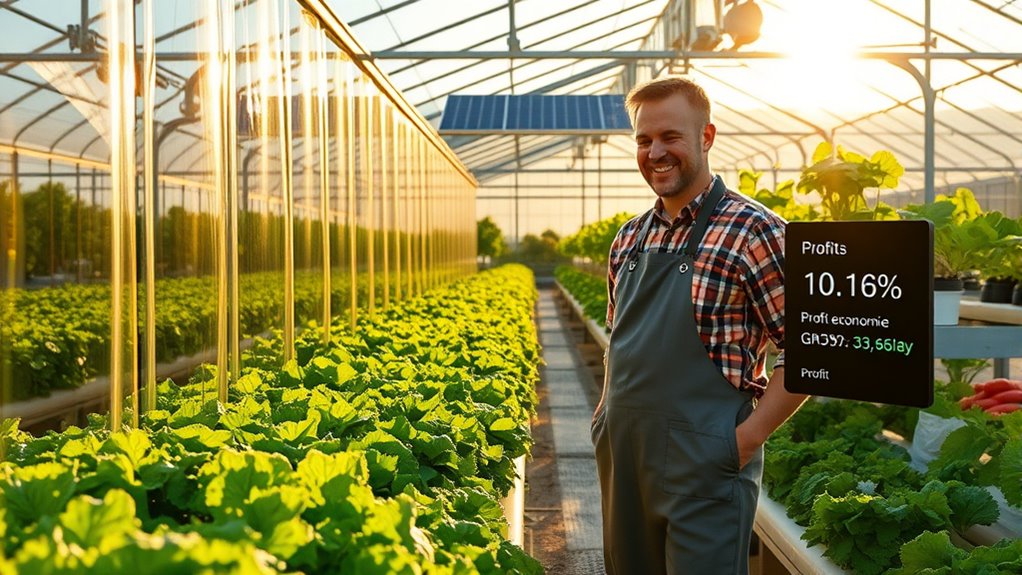
While exploring modern agriculture, you’ll find that greenhouse farming offers substantial economic benefits that can transform your approach to food production.
With increased yields and the ability to grow high-value crops, you can command premium prices in the market. Greenhouses also reduce operational costs through water and energy efficiency, ensuring higher profit margins. Additionally, increased production through efficient resource utilization enables you to maximize the use of available space, driving profitability even further. Implementing energy efficiency measures in greenhouse operations can further enhance cost savings and sustainability.
Year-round production secures stable income streams and long-term contracts with retailers. Plus, many governments provide grants and subsidies, easing initial investments.
By understanding consumer preferences and market trends, you can cater to niche markets and maximize profits.
Ultimately, greenhouse farming not only enhances resource efficiency but also mitigates risks associated with traditional agriculture, paving the way for a more sustainable and profitable future.
Frequently Asked Questions
How Do I Start My Own Greenhouse Farm?
To start your own greenhouse farm, begin by selecting a suitable site that’s close to your market.
Assess the local climate to choose the right crops and design.
Establish a budget to determine your scale and type of greenhouse.
Conduct market research to identify crop demand.
Make sure you comply with local regulations.
Finally, invest in the right structure, equipment, and systems to maintain ideal growing conditions for your plants.
What Crops Are Best for Greenhouse Farming?
Imagine you’ve just harvested your first batch of vibrant tomatoes from your greenhouse.
For greenhouse farming, tomatoes are a top choice due to their high demand and potential for year-round production.
You should also consider leafy greens like lettuce, which grow quickly, or cucumbers, which can be ready in just 55 days.
Peppers add versatility, while herbs like basil can boost your market appeal.
Each crop offers unique benefits, so choose wisely!
How Much Does It Cost to Build a Greenhouse?
Building a greenhouse can cost between $5 to $35 per square foot, depending on the materials and design you choose.
For example, hoop houses are budget-friendly, while glass greenhouses provide better aesthetics and light.
You’ll also need to factor in site preparation, labor, and utility installation costs.
What Are the Maintenance Requirements for Greenhouses?
Imagine your greenhouse as a ship sailing smoothly through the seasons. To keep it afloat, you’ve got to regularly inspect the frame, maintain gutters, and care for the glazing.
You’ll adjust environmental controls like temperature and humidity, ensuring all systems run well.
Don’t forget to monitor for pests and diseases, keeping your crew—your plants—safe.
With regular checks and maintenance, you’ll navigate the challenges and enjoy a bountiful harvest.
Can Greenhouses Operate Independently Without External Resources?
Yes, greenhouses can operate independently without external resources by integrating renewable energy sources like solar panels and employing automated systems for water management and climate control.
You can collect rainwater, recycle water, and use energy-efficient technologies like thermal mass and insulation.
With proper crop selection and management techniques, such as vertical growing and integrated pest management, your greenhouse can thrive sustainably while minimizing dependence on outside inputs.
Conclusion
As you step into the future of greenhouse farming, picture a vibrant tapestry of innovation and sustainability woven together. With each new technology and method, you’re not just growing food; you’re nurturing a greener planet. Embrace the rise of vertical farming and urban greenspaces, where fresh produce flourishes like wildflowers in a cityscape. Together, you can cultivate not only crops but also a thriving economy that blooms in harmony with nature. The future’s ripe for the picking!
